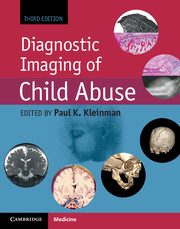Book contents
- Frontmatter
- Dedication
- Contents
- List of Contributors
- Editor’s note on the Foreword to the third edition
- Foreword to the third edition
- Foreword to the second edition
- Foreword to the first edition
- Preface
- Acknowledgments
- List of acronyms
- Introduction
- Section I Skeletal trauma
- Section II Abusive head and spinal trauma
- Section III Visceral trauma and miscellaneous abuse and neglect
- Section IV Diagnostic imaging of abuse in societal context
- Section V Technical considerations and dosimetry
- Chapter 28 Radiologic image formation: physical principles, technology, and radiation dose considerations
- Chapter 29 The physics and biology of magnetic resonance imaging: medical miracle anyone?
- Chapter 30 Quality assurance and radiographic skeletal survey standards
- Index
- References
Chapter 29 - The physics and biology of magnetic resonance imaging: medical miracle anyone?
from Section V - Technical considerations and dosimetry
Published online by Cambridge University Press: 05 September 2015
- Frontmatter
- Dedication
- Contents
- List of Contributors
- Editor’s note on the Foreword to the third edition
- Foreword to the third edition
- Foreword to the second edition
- Foreword to the first edition
- Preface
- Acknowledgments
- List of acronyms
- Introduction
- Section I Skeletal trauma
- Section II Abusive head and spinal trauma
- Section III Visceral trauma and miscellaneous abuse and neglect
- Section IV Diagnostic imaging of abuse in societal context
- Section V Technical considerations and dosimetry
- Chapter 28 Radiologic image formation: physical principles, technology, and radiation dose considerations
- Chapter 29 The physics and biology of magnetic resonance imaging: medical miracle anyone?
- Chapter 30 Quality assurance and radiographic skeletal survey standards
- Index
- References
Summary
In perhaps one of the greatest marriages ever conceived between two distinct and proudly independent scientific fields, physics and biology, magnetic resonance imaging (MRI) emerged to benefit humankind. Securely ensconced in the medical arena, MRI is a noninvasive diagnostic imaging tool with unique and unparalleled capabilities that daily generate anatomic and functional data for radiologic diagnosis and patient management decisions throughout the world. Indeed, after only some 30 years in use and development, a world without MRI seems inconceivable in the context of modern medical practice and scientific inquiry. As has been illustrated in preceding chapters, MRI has become integral to the assessment of abusive head and spinal trauma. Furthermore, with the use of spectroscopy, diffusion-weighted and perfusion imaging, it has begun to elucidate the complex cascade of events that occur following inflicted neurotrauma. It also plays an important role in the delineation of an array of abusive musculoskeletal injuries and it is occasionally applied to cases of thoracoabdominal trauma.
So, how does it work and why does it work so well? Herein I attempt to answer these questions by offering relatively nontechnical explanations of MRI that incorporate the essential physical and biologic elements responsible for this medical miracle. Since this textbook speaks to a diverse audience with variable interests and affinities for this complex subject, this chapter is as an introduction to the newcomer, and for the more experienced, a vehicle for deeper intuitive understanding of this challenging topic.
- Type
- Chapter
- Information
- Diagnostic Imaging of Child Abuse , pp. 688 - 707Publisher: Cambridge University PressPrint publication year: 2015



